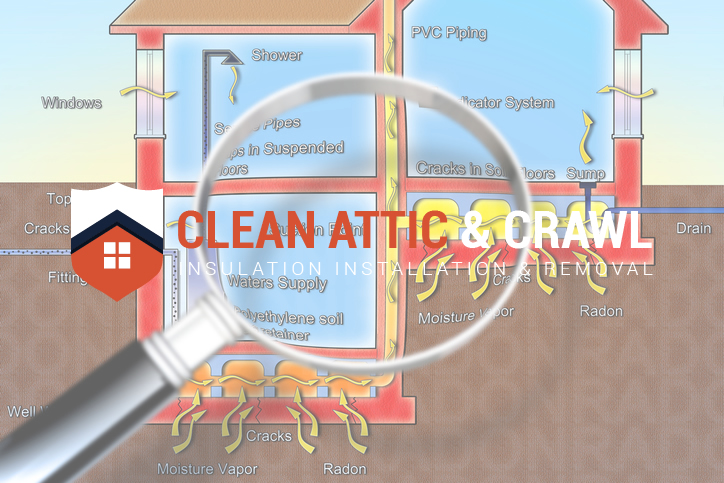Crawl spaces are often unheated, which can lead to moisture and mold problems. Heating a crawl space is relatively simple and can be done in a few different ways. One way is to install electric baseboard heaters.
Another way is to install a gas-fired space heater. Yet another option is to run ductwork from your home’s existing heating system into the crawl space. Whichever method you choose, make sure that the crawl space is properly insulated so that the heat does not escape.
- Check the crawl space for any water leaks or standing water
- If there is water present, you will need to address this issue before continuing
- Inspect the insulation in the crawl space
- If it is damp or wet, it will need to be replaced
- Install a vapor barrier on the ground if one is not already present
- This will help to prevent moisture from coming up through the floor and into the crawl space
- Seal any gaps or cracks in the foundation with caulk or expanding foam sealant to help further prevent moisture from entering the space
- Place a dehumidifier in the crawl space and turn it on to help remove any remaining moisture in the air
Can Dehumidifier Warm My Floors?
How to Heat Floor above Crawl Space?
Heating a floor above a crawl space can be done in a few ways. One way is to install electric radiant floor heating mats or cables. Another way is to install hydronic (hot water) tubing on the floor.
Radiant floor heating is a type of space heating that heats floors from the bottom up. Radiant heat produces infrared waves that travel through the air and are absorbed by objects in the room, including people and furniture. The heat warms objects in the room, rather than just circulating around the room as forced-air systems do.
Hydronic radiant floors use plastic tubing filled with hot water that runs underneath the flooring. The tubing can be installed in many different patterns, depending on the size and layout of your floor.
Crawl Space Heater to Keep Pipes from Freezing
If you’re like most people, you probably don’t think much about your crawl space. But if you live in an area where the temperatures can dip below freezing, it’s important to pay attention to this often-forgotten space. Why?
Because that’s where your home’s pipes are located. And if those pipes freeze, you could be facing a costly repair bill.
One way to protect your pipes from freezing is to install a crawl space heater.
These heaters are designed to keep the temperature in your crawl space above freezing, even when the outside temperature plummets. That way, your pipes will be less likely to freeze – and burst.
Crawl space heaters come in a variety of sizes and styles, so you can choose the one that best fits your needs.
Some are electric and some run on natural gas or propane. There are also different installation options available, depending on the layout of your crawl space.
If you’re not sure which type of heater is right for you, talk to a professional contractor or plumber who can help you make the best decision for your home.
Protecting your pipes from freezing is an important part of maintaining your home – and it could save you a lot of money in the long run!
Best Heater for Crawl Space
As the weather gets colder, many homeowners start to think about how they can best heat their homes. One area that is often overlooked is the crawl space. This is a common mistake because people don’t realize that the crawl space is actually a part of the house.
The crawl space is where the foundation and floors meet, and it’s important to keep this area warm in order to prevent damage to your home. There are several different ways to heat a crawl space, but one of the most effective is with an electric heater. Electric heaters are readily available and relatively inexpensive, making them a great option for those on a budget.
They’re also easy to install, so you won’t have to hire a professional or take on any complicated projects yourself. When choosing an electric heater for your crawl space, it’s important to select one that’s powerful enough to heat the entire area. You’ll also want to make sure that it has features like automatic shut-off and tip-over protection, which will help keep your family safe while using it.
With so many options on the market, finding the right electric heater for your needs shouldn’t be difficult.
Safest Heater for Crawl Space
As the weather turns colder, many homeowners begin to think about how they will heat their homes. For those with a crawl space, this can be a particular concern. After all, you don’t want to put anything in your crawl space that could start a fire or produce harmful fumes.
So what is the best and safest heater for a crawl space?
There are actually several types of heaters that are safe for use in a crawl space. The most common type is an electric infrared heater.
These heaters work by emitting infrared waves which heat up objects in their path. This means that they won’t overheat the air in your crawl space, making them much safer than other types of heaters.
Another type of safe heater for your crawl space is a gas-fired unit.
These units need to be vented properly, but if they are they can provide warmth without any risk of starting a fire. Just be sure to have them installed by a professional so that you know they are vented correctly.
Finally, another option is to use an oil-filled radiator heater.
These heaters work by heating up oil inside of them and then circulating the warm air around the room using fans. They too must be properly ventilated so as not to cause any fires, but when used correctly they can provide gentle and effective warmth for your crawl space all winter long!

Credit: localinsulationpros.com
Should a Crawlspace Be Heated?
A crawlspace is an unoccupied space in a building that provides access to plumbing and wiring. Heating a crawlspace is not always necessary, but there are some cases where it may be beneficial. Here are some things to consider when deciding whether or not to heat your crawlspace:
The climate in your area – If you live in an area with cold winters, heating your crawlspace can help prevent frozen pipes.
The type of foundation your home has – Homes with slab foundations (i.e. no basement or crawlspace) are less likely to need a heated crawlspace than homes with pier-and-beam foundations. This is because the concrete slab acts as a barrier against the cold ground, keeping the interior of the home warm.
Your home’s energy efficiency – If your home is well-insulated and has energy-efficient windows, you may not need to heat your crawlspace at all. Conversely, if your home is poorly insulated and/or has single-pane windows, heating your crawlspace can help improve energy efficiency.
The use of the space – If you plan on using the crawlspace for storage, it may be worth considering heating it so that items stored in the space do not freeze or become damaged by moisture condensation.
Can You Put a Heater in a Crawl Space?
Yes, you can put a heater in a crawl space. There are several things to consider when doing so, however. First, you need to make sure that the crawl space is properly ventilated.
If it is not, then the heater will not work as efficiently and could potentially cause problems with moisture buildup. Second, you need to determine the best location for the heater. It should be placed in an area where it will not be obstructed by any objects or debris.
Third, you need to choose the right size heater for the space. Too small of a unit will not provide enough heat, while too large of a unit could overheat the space and become a safety hazard.
How Can I Keep My House Warm in a Crawl Space?
If your home has a crawl space, you may be wondering how to keep it warm. After all, this is an area of your home that is typically not well-insulated and can be quite drafty. Here are a few tips to help you keep your crawl space warm:
1. Use a space heater. This is probably the most obvious solution, but it is also the most effective. Place a space heater in your crawl space and turn it on when needed.
Just be sure to keep an eye on it so that it doesn’t overheat the area. 2. Insulate the walls and ceiling. This will help to prevent heat from escaping through the walls and ceiling of your crawlspace.
You can use insulation batts or blankets, or spray foam insulation. 3. Install weather stripping around doors and windows leading into the crawlspace. This will help to seal off any drafts that might be coming in from outside.
How Do You Heat a Crawl Space to Keep Pipes from Freezing?
One of the best ways to heat a crawl space and keep pipes from freezing is to use an electric space heater. Electric space heaters are safe, reliable, and easy to use. Simply plug the heater into an outlet and turn it on.
Be sure to place the heater in a location where it will not be in the way or pose a safety hazard. Another way to heat a crawl space is to use an outdoor wood furnace. These furnaces can be used to heat your home as well as your crawl space.
By placing the furnace near your crawl space, you can direct warmth into the area, helping to prevent pipes from freezing.
Conclusion
If you have a crawl space, you know that it can be difficult to keep warm. Here are a few tips on how to heat a crawl space so that it is comfortable for you and your family. First, consider installing insulation in your crawl space.
This will help to keep the heat in and the cold out. You can also use a vapor barrier to help with this. Second, make sure that you have adequate ventilation in your crawl space.
This will allow the air to circulate and keep the space from becoming too humid. Third, consider using a space heater in your crawl space. This will help to take the chill off of the air and make it more comfortable for you and your family.
Make sure that you follow all of the safety instructions when using any type of heater. fourth, if you have electric heat, make sure that you are using energy-efficient bulbs so that you are not wasting money on your heating bill. These bulbs will last longer and save you money in the long run.
fifth, during the winter months, open up all of the windows in your home so that sunlight can enter the crawlspace and help to warm it up naturally. Sixth, if possible, try to seal off any cracks or gaps around doors and windows so that drafts cannot enter the space.
